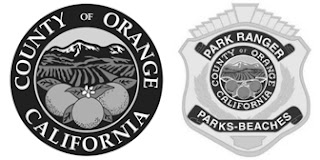Every five years or so, like clockwork, the Board decides a Section 2(b) case. This time it affirmed refusals to register the two proposed marks depicted below, for various governmental services (e.g., maintaining parks and libraries), on the ground that they constitute insignia of a governmental entity, i.e., a "municipality." The Board rejected the argument that Orange County is not a municipality, and also rejected the argument that because Orange County already has an "official" seal, these design cannot be insignia of the county. County of Orange, Serial Nos. 87419378 and 87639750 (August 4, 2022) [precedential] (Opinion by Judge Martha B. Allard).
Section 2(b) is a complete bar to registration of a mark that "[c]onsist of or comprises the flag or coat of arms or other insignia of . . . any State or municipality ...." It is based on the idea that "official government insignia . . . should not be registered as symbols of origin for commercial goods and services." 3 J. THOMAS MCCARTHY, MCCARTHY ON TRADEMARKS AND UNFAIR COMPETITION § 19:78 (5th ed. 2022).
Insignia? The Board first focused on the "Circular Mark" on the left IT observed that the term "insignia" has multiple meanings, including "a distinguishing mark or sign" and "an emblem." The Circular Mark has not gone through the two-step process set out in the California Government Code to make it an "official seal" of Orange County. In fact, Orange County has an "official" seal, shown immediately below. The Board pointed out, however, that formal adoption as an "official" seal is not a requirement of Section 2(b)

Evidence submitted by Examining Attorney Christina Calloway showed that the Circular Mark is displayed prominently on the county's website, which provides links to various services offered by the county, such as business licenses and payment of property tax bills. It is also displayed on the website for the Clerk-Recorder's office, which manages many official government documents such as marriage licenses and death certificates. The Mark appears prominently on signage for county offices, in cluding the county courthouse, appears on the wall of the meeting room of the County Board of Supervisors, and on maps depicting the location of county offices.
Municipality?: The Board took judicial notice of a definition of the term "municipality" as "A city, town, or other local political entity with the powers of self government." Applicant acknowledged that the Californa Constitution provides that a county may have some such powers: for example, a county may make and enforce local ordinances, may sue and be sued, and may levy and collect taxes. And a county may adopt a charter. The Board therefore concluded that Orange County is a "municipality" for purposes of Section 2(b)
Applicant argued that state law should control because applicant was created and is governed by California law. The Board disagreed: "[I]n the absence of a plain indication to the contrary, it is to be assumed when Congress enacts a statute that it does not intend to make its application dependent on state law." Dickerson v. New Banner Inst., Inc., 460 U.S. 103, 119 (1983) (cleaned up; citation omitted)."
The Badge Mark: Unsurprisingly, as to applicant's other mark, the "Badge Mark," the same analysis applied.
ead comments and post your comment here.
TTABlog comment: So a county is a municipality? Who knew?
The content of this article is intended to provide a general guide to the subject matter. Specialist advice should be sought about your specific circumstances.


